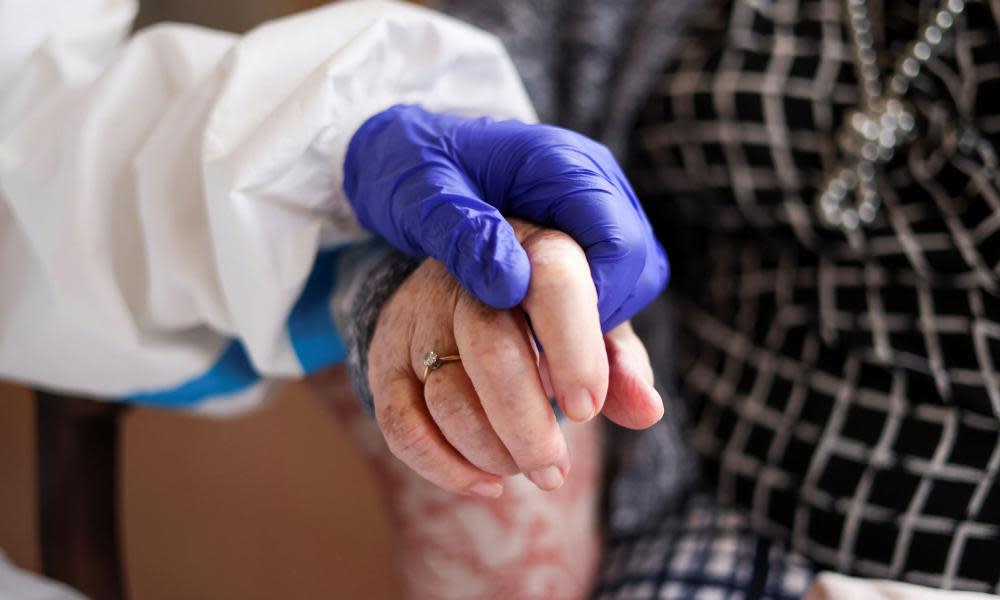What are the new Covid rules for English care homes and are they safe?

From Monday, coronavirus restrictions related to care homes in England will be eased. Here are the changes, and the science behind them.
What’s changing?
Residents who test positive will have to self-isolate for up to 10 days, with a minimum isolation period of five full days followed by two sequential negative lateral flow tests – as is already the case for the rest of the population.
Isolation periods for those having care after an emergency hospital visit will also be reduced to a maximum of 10 days, while a requirement for residents to test or self-isolate after normal visits out will be removed.
Care homes will have to follow outbreak management rules for 14 rather than 28 days, and by 16 February care workers will need to use lateral flow tests before work rather than taking a weekly PCR test.
The limit on visitors to care homes will be lifted. Visitors should still obtain a negative lateral flow test result earlier in the day of their visit, and guidance on the use by visitors of PPE such as face masks remains unchanged.
Why are the rules easing?
According to the Department of Health and Social Care (DHSC), it has been enabled by a successful booster vaccination programme, with 86.5% of care home residents having had their booster jab.
The latest data from the UK Health Security Agency (UKHSA) shows that with a Pfizer booster – regardless of the vaccines used for previous doses – the effectiveness against hospitalisation is about 90% shortly after receiving the jab, falling to about 75% after 10 to 14 weeks. Very high levels of protection are also seen for Moderna boosters. The figures suggest vaccine effectiveness against death in people aged 50 and older is about 95% two weeks after a booster.
What are the rules around staff vaccinations?
The DHSC says: “Since 11 November last year all care home workers, and anyone entering a care home, have needed to be fully vaccinated, unless they are exempt under the regulations.” That means there may be some staff who, for medical reasons, have not been vaccinated.
Are the changes safe?
The care minister, Gillian Keegan, said the changes were backed by scientists, and experts largely agree. “If lateral flow tests are used in conjunction to prevent most contact with infectious people, then broadly speaking the risk will be low,” said Prof Rowland Kao, an epidemiologist at the University of Edinburgh and member of the modelling group Spi-M.
He said there remained an issue for residents and staff when it came to those with existing conditions or who were unvaccinated, either by choice or for other reasons. “In those cases there should be measures and protocols in place to prevent them from being viewed as second-class citizens,” he said.
Ian Hall, a professor of mathematical epidemiology and statistics at the University of Manchester and a member of the Scientific Advisory Group for Emergencies (Sage), backed the changes. “The decision was reviewed scientifically and is a balance of harms of Covid but also the harm of deconditioning and wellbeing from isolation in a highly vaccinated population,” he said. “We strongly recommended that measures are put in place to observe the impact of these measures following implementation and if there are clear episodes of transmission the risk assessment is reviewed.”
Others cautioned against easing measures any further. Dr Helen Salisbury, a GP in Oxford, said it would be “foolhardy” to remove the need for lateral flow tests and masks for visitors, noting that not everyone who had three jabs had had a strong immune response, that people tend to develop more health problems as they get older, and that even among the vaccinated, the risks from Covid increase with age.
“I’m delighted if people are able to see their families, but it doesn’t make sense to me to lift all restrictions completely,” she said.

 Yahoo News
Yahoo News 
